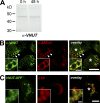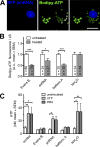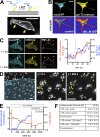ATP is stored in lamellar bodies to activate vesicular P2X4 in an autocrine fashion upon exocytosis
- PMID: 29282210
- PMCID: PMC5806682
- DOI: 10.1085/jgp.201711870
ATP is stored in lamellar bodies to activate vesicular P2X4 in an autocrine fashion upon exocytosis
Abstract
Vesicular P2X4 receptors are known to facilitate secretion and activation of pulmonary surfactant in the alveoli of the lungs. P2X4 receptors are expressed in the membrane of lamellar bodies (LBs), large secretory lysosomes that store lung surfactant in alveolar type II epithelial cells, and become inserted into the plasma membrane after exocytosis. Subsequent activation of P2X4 receptors by adenosine triphosphate (ATP) results in local fusion-activated cation entry (FACE), facilitating fusion pore dilation, surfactant secretion, and surfactant activation. Despite the importance of ATP in the alveoli, and hence lung function, the origin of ATP in the alveoli is still elusive. In this study, we demonstrate that ATP is stored within LBs themselves at a concentration of ∼1.9 mM. ATP is loaded into LBs by the vesicular nucleotide transporter but does not activate P2X4 receptors because of the low intraluminal pH (5.5). However, the rise in intravesicular pH after opening of the exocytic fusion pore results in immediate activation of vesicular P2X4 by vesicular ATP. Our data suggest a new model in which agonist (ATP) and receptor (P2X4) are located in the same intracellular compartment (LB), protected from premature degradation (ATP) and activation (P2X4), and ideally placed to ensure coordinated and timely receptor activation as soon as fusion occurs to facilitate surfactant secretion.
© 2018 Fois et al.
Figures







Comment in
-
A role for P2X4 receptors in lysosome function.J Gen Physiol. 2018 Feb 5;150(2):185-187. doi: 10.1085/jgp.201711963. Epub 2018 Jan 22. J Gen Physiol. 2018. PMID: 29358186 Free PMC article.
References
-
- Abbracchio M.P., Burnstock G., Boeynaems J.M., Barnard E.A., Boyer J.L., Kennedy C., Knight G.E., Fumagalli M., Gachet C., Jacobson K.A., and Weisman G.A.. 2006. International Union of Pharmacology LVIII: update on the P2Y G protein-coupled nucleotide receptors: From molecular mechanisms and pathophysiology to therapy. Pharmacol. Rev. 58:281–341. 10.1124/pr.58.3.3 - DOI - PMC - PubMed
-
- Andronescu C., Poller S., and Schuhmann W.. 2014. Electrochemically induced deposition of poly(benzoxazine) precursors as immobilization matrix for enzymes. Electrochem. Commun. 41:12–15. 10.1016/j.elecom.2014.01.015 - DOI
Publication types
MeSH terms
Substances
Associated data
- Actions
LinkOut - more resources
Full Text Sources
Other Literature Sources

